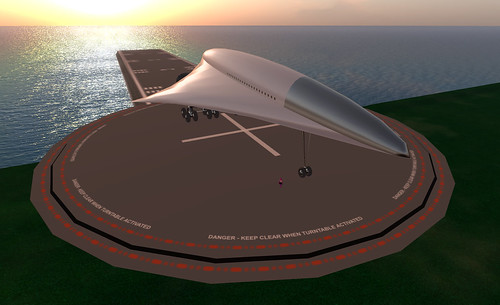As Enclave Harbour comes closer to completion, it is time to start sharing some of its objectives. Enclave Harbour has several goals and part of its mission statement includes raising environmental awareness.
This is done by including obvious “green” practices, such as a solar array farm and wind turbines, and subtle practices such as pitchered water and glasses versus bottled water for meetings. Ener is doing a wonderful job of building with a “green” attitude (and a thank you to DreamWalker for scripting those).
Including such elements in a virtual world setting does help keep environmental awareness in the forefront. However, we also go beyond simply incorporating such things to developing formal programmes to explore environmental science.
As a former middle and high school science teacher, then later a professor of college Geology and Environmental Science, coupled with a Bachelors in Physical Science (major Geology, minor Chemistry), I am enjoying developing virtual world facilitated educational activities.
While early in it’s development, several learning “tracks” are in the works. One geared toward middle school Earth Science, another to high school as a possible mentor programme, and perhaps a corporate track.
Let’s take a look at a quick example: a fantasy jet.
For middle school use, you can illustrate that hot exhaust gases cool in the atmosphere and create “contrails”, or condensation trails. You can refer to these as artificial clouds and tie into the water cycle as an example of condensation. You can also introduce the concept of carbon footprints, as well as aerodynamics, lift, and more. As a supplementary exercise, the sky is the limit (pardon the pun). =)
At the high school level, you can discuss adiabatic change, when a compressed gas expands and loses heat. This can lead to discussions on entropy, jet propulsion, environmental costs both in the air and on the ground (as in avian migratory patterns – interesting species such as the snowy owl of Boston’s Logan airport – and the real cost to airport administrators and travelers). Details such as adiabatic change, while not strictly tied to air pollution, are important in environmental science literacy. Apart from keeping air pollutants suspended, condensation trails have long been considered as climate factors.
The thought being that additional and perpetual “cloud” coverage from daily jet traffic both holds in some of Earth’s emissivity (the release of infrared energy from Earth’s surface – that energy having been imparted by the sun shining on our planet) and increases the reflection of the sun’s solar energy (albedo). This was thought to have been proven when data was collected in the three days that air traffic was suspended in the US after the attacks of 9/11. A difference in daily temperature fluctuation of 1 degree Celsius during those three days was attributed to contrails.
However, subsequent studies tend to point to natural factors affecting that change. This type of exploration is key to students learning to look at the world differently and understand that science is not separate from our lives, but rather a part of it. And to question science. After all, part of the scientific method is to be open minded – something science is actually somewhat poor at doing. It often takes years for science to make changes (Alfred Wegener proposed continental drift in 1912 yet it was not regarded as possible until the 1970s – I have a National Geographic atlas from 1968 touting the expanding Earth theory for the continental and oceanic plates).
You get the idea, this one “build” can be used in many ways and serves as a catalyst to expand beyond itself. From simple observations “why do planes leave white trails in the sky?” to term papers discussing any number of details.
Stay tuned for more information about Enclave Harbour in Reaction Grid!

this post also carried on the iliveisl blog
